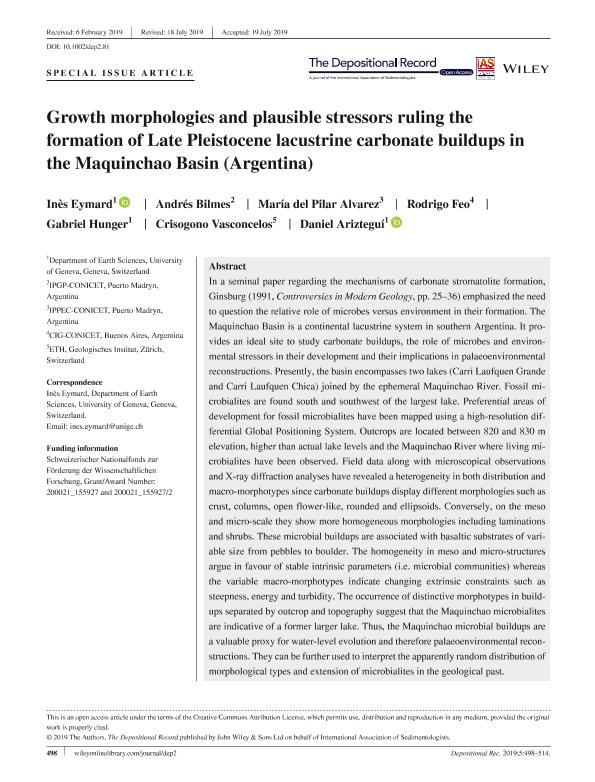Mostrar el registro sencillo del ítem
dc.contributor.author
Eymard, Inès
dc.contributor.author
Bilmes, Andrés

dc.contributor.author
Alvarez, Maria del Pilar

dc.contributor.author
Feo, Rodrigo Nahuel

dc.contributor.author
Hunger, Gabriel
dc.contributor.author
Vasconcelos, Crisogono
dc.contributor.author
Ariztegui, Daniel

dc.date.available
2020-02-03T21:41:58Z
dc.date.issued
2019-07-22
dc.identifier.citation
Eymard, Inès; Bilmes, Andrés; Alvarez, Maria del Pilar; Feo, Rodrigo Nahuel; Hunger, Gabriel; et al.; Growth morphologies and plausible stressors ruling the formation of Late Pleistocene lacustrine carbonate buildups in the Maquinchao Basin (Argentina); Wiley; The Depositional Record; 5; 3; 22-7-2019; 498-514
dc.identifier.issn
2055-4877
dc.identifier.uri
http://hdl.handle.net/11336/96654
dc.description.abstract
In a seminal paper regarding the mechanisms of carbonate stromatolite formation, Ginsburg (1991) emphasized the need to question to the relative role of microbes versus environment in their formation. The Maquinchao Basin is a continental lacustrine system in southern Argentina. It provides an ideal site to study carbonate buildups, the role of microbes and environmental stressors in their development and their implications in palaeoenvironmental reconstructions. Presently the basin encompasses two lakes (Carri Laufquen Grande and Carri Laufquen Chica) joined by the ephemeral Maquinchao River. Fossil microbialites are found south and southwest of the largest lake. Preferential areas of development for fossil microbialites have been mapped using a high‐resolution differential Global Positioning System. Outcrops are located between 820 m and 830 m elevation, higher than actual lake levels and the Maquinchao River where living microbialites have been observed. Field data along with microscopical observations and X‐ray Diffraction (XRD) analyses have revealed a heterogeneity in both distribution and macro‐morphotypes since carbonate buildups display different morphologies such as crust, columns, open flower‐like, rounded and ellipsoids. Conversely, on the meso and micro‐scale they show more homogenous morphologies including laminations and shrubs. These microbial buildups are associated with basaltic substrates of variable size from pebbles to boulder. The homogeneity in meso and micro‐structures argue in favour of stable intrinsic parameters (i.e. microbial communities) whereas the variable macro‐morphotypes indicate changing extrinsic constraints such as steepness, energy and turbidity. The occurrence of distinctive morphotypes in buildups separated by outcrop and topography suggest that the Maquinchao microbialites are indicative of former larger lake. Thus, the Maquinchao microbial buildups are a valuable proxy for water‐level evolution and therefore palaeoenvironmental reconstructions. They can be further used to interpret the apparently random distribution of morphological types and extension of microbialites in the geological past.
dc.format
application/pdf
dc.language.iso
eng
dc.publisher
Wiley

dc.rights
info:eu-repo/semantics/openAccess
dc.rights.uri
https://creativecommons.org/licenses/by/2.5/ar/
dc.subject
CARBONATE
dc.subject
LACUSTRINE
dc.subject
MICROBIALITE
dc.subject
PALAEOSHORELINES
dc.subject
PATAGONIA
dc.subject.classification
Geología

dc.subject.classification
Ciencias de la Tierra y relacionadas con el Medio Ambiente

dc.subject.classification
CIENCIAS NATURALES Y EXACTAS

dc.title
Growth morphologies and plausible stressors ruling the formation of Late Pleistocene lacustrine carbonate buildups in the Maquinchao Basin (Argentina)
dc.type
info:eu-repo/semantics/article
dc.type
info:ar-repo/semantics/artículo
dc.type
info:eu-repo/semantics/publishedVersion
dc.date.updated
2019-12-11T18:53:00Z
dc.journal.volume
5
dc.journal.number
3
dc.journal.pagination
498-514
dc.journal.pais
Estados Unidos

dc.journal.ciudad
Hoboken
dc.description.fil
Fil: Eymard, Inès. University of Geneva; Suiza
dc.description.fil
Fil: Bilmes, Andrés. Consejo Nacional de Investigaciones Científicas y Técnicas. Centro Científico Tecnológico Conicet - Centro Nacional Patagónico. Instituto Patagónico de Geología y Paleontología; Argentina
dc.description.fil
Fil: Alvarez, Maria del Pilar. Consejo Nacional de Investigaciones Científicas y Técnicas. Centro Científico Tecnológico Conicet - Centro Nacional Patagónico. Instituto Patagónico para el Estudio de los Ecosistemas Continentales; Argentina
dc.description.fil
Fil: Feo, Rodrigo Nahuel. Consejo Nacional de Investigaciones Científicas y Técnicas. Centro Científico Tecnológico Conicet - La Plata. Centro de Investigaciones Geológicas. Universidad Nacional de La Plata. Facultad de Ciencias Naturales y Museo. Centro de Investigaciones Geológicas; Argentina
dc.description.fil
Fil: Hunger, Gabriel. University of Geneva; Suiza
dc.description.fil
Fil: Vasconcelos, Crisogono. Geologisches Institut; Suiza
dc.description.fil
Fil: Ariztegui, Daniel. University of Geneva; Suiza
dc.journal.title
The Depositional Record
dc.relation.alternativeid
info:eu-repo/semantics/altIdentifier/url/https://onlinelibrary.wiley.com/doi/abs/10.1002/dep2.81
dc.relation.alternativeid
info:eu-repo/semantics/altIdentifier/doi/http://dx.doi.org/10.1002/dep2.81
Archivos asociados
